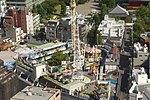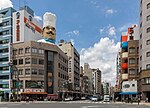Denkikan

The Denkikan (電気館) was the first dedicated movie theater in Japan. Originally a hall built in Asakusa's Rokku theater district to present spectacles featuring electricity ("denki" in Japanese), it was converted into a movie theater in October 1903 by Yoshizawa Shōten, the most successful of the film companies at the time. Featuring benshi such as Saburo Somei, it quickly became the symbol of the new phenomenon of the motion pictures and many cinemas around Japan were later created that borrowed the name "Denkikan." It later became a Nikkatsu theater and then a Shochiku theater before finally closing in 1976. A historically accurate model of the theater is currently on display at the Edo-Tokyo Museum in Tokyo. It is also cited in Kaizo Hayashi's film To Sleep so as to Dream.
Excerpt from the Wikipedia article Denkikan (License: CC BY-SA 3.0, Authors, Images).Denkikan
Rokku-dori, Taito Asakusa
Geographical coordinates (GPS) Address Nearby Places Show on map
Geographical coordinates (GPS)
| Latitude | Longitude |
|---|---|
| N 35.713125 ° | E 139.79329444444 ° |
Address
パシフィックコート浅草
Rokku-dori
111-0032 Taito, Asakusa
Japan
Open on Google Maps










